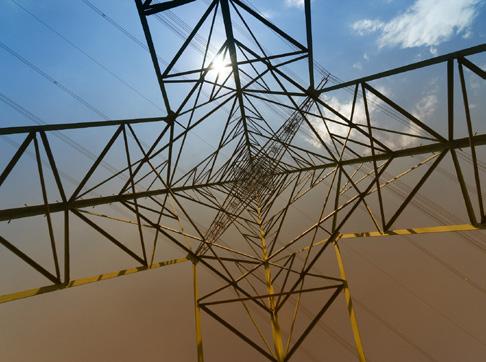
7 minute read
Gossage
Pyrrhic victory for Poland
The Polish prime minister, Mateusz Morawiecki, returned to Warsaw waving the European Council 2030 expenditure deal, and claiming victory. Poland is the only EU country refusing to agree to reach net-zero emissions by 2050, and an earlier draft text had said countries must accept this target in order to receive climate funds for greening the economy. But Morawiecki used his veto threat to convince other leaders to drop this demand. The result is that Poland will still be able to access 50% of those funds without signing up to the climate goal. Plans by Swiss technology absolutely feasible.”
Advertisement
“We won better rules than what the and replacing coal-fired
European Commission proposed [with] the possibility of getting 50% immediately, without committing to the climate target,” boasted Morawiecki. What he failed to mention is that his victory is largely hollow. Because the trade-off he agreed shrinks by half of a new climate abatement funding that had been created specifically at the request of Warsaw. Poland could have had 100% of a potential €38 Fund’, aimed at supporting coal-reliant countries’ transition to clean energy economies. Instead it will get 50% of a potential €18 billion –all for exclusion from a 2050 goal most reckon Poland will eventually sign up to anyway during 2021.
Solar lakes
company and solar panel manufacturer Meyer Burger to build a 10GW floating solar plant on a lake due to be left behind by the future closure of Germany’s Hambach coal mine, is gaining support from the local scientific community. Uwe Rau, director of the Institute for Energy and Climate Research at the Forschungszentrum Juelich research centre, describes the company’s proposal in the state of North RhineWestphalia as, “perfect and Noting that it was an ideal situation for the region, Rau maintains installing solar parks in opencast mines billion top-up via this ‘Just Transition
power stations would offer a double advantage, because electricity pylons and lines leading away from coal-fired power plants would not have to be dismantled and erected elsewhere.
“It also fits in very well in terms of scale: the solar park could generate just as much electricity as all of today’s coal-fired power plants in North Rhine-Westphalia’s mining district combined.”
Chinese torture
The Conservative backwoodsmen MPs smell blood on China. They have already reversed Government policy and banned Huawei from involvement in rolling out the fifth generation (5G) of wireless communications networks. They now intend to stop another Chinese firm, CGN, from showcasing its HPR1000 technology when building a replacement nuclear power station at Bradwell in Essex. The MPs will achieve this by amending the forthcoming National Security and Investment Bill. Trouble is, CGN already have contracts signed to part-fund nuclear power stations together with Electricité de France, at Hinkley Point in Somerset and Sizewell in Suffolk. In both cases, the Chinese have absolutely key engineering roles, with know-how not easily replaced. The big question is: if CGN were chucked out of Bradwell, whether they would also walk away from the other two projects. Of course in doing so, they would then be in breach of many existing contractual obligations. But, in such circumstances, good luck with suing the Chinese government.
When electricity money talks
You may have heard about the $60 million electricity political slush fund run by the (now former) Republican party speaker (e.g. leader) of the Ohio House of Representatives, Larry Householder. It turns out, that once this money had been collected, Householder pushed through a huge bailout of two nuclear plants and several coal plants, all of which were losing serious money. Simultaneously, he also gutted most of Ohio’s standards on energy efficiency and clean energy, which were weak to begin with. This case looks to be truly malodorous. Householder appears to have won his high office largely because the power company, FirstEnergy, and its affiliates – most prominent of which was America’s biggest coal firm, Murray Energy – were funding his political operation under the table, using a ‘nonprofit’ shell corporation that he controlled. That allowed him to pump huge sums into the campaigns of allied candidates who, after winning their legislative seats, voted to give him the speakership. Then they voted in favour of his highest priority, the bailout bill. FBI prosecutors claim that $400,000 of the power company’s money went directly into Householder’s pocket as he was doing the company’s bidding in the Ohio Statehouse.
Ohio is one of the most marginal states, which could make the difference for Donald Trump’s re-election bid this November 3.
Despite being from the same political party as Householder, Trump has set out entirely to distance himself from this giant scandal. But to do so convincingly, Trump needs to fire his Cabinet member whom he personally placed in charge of the (seriously misnamed) Environmental Protection Agency, instructing him to push back on efficiency standards for electricity using equipment. His name is Andrew Wheeler.
Why does Trump need to do so? Want to know who was Murray Energy’s chief lobbyist when it funnelled over $100,000 to Householder’s slush fund in 2016? Step forward, the very same Andrew Wheeler.

Your perfect first line of defence: detect faults before they become failures
Catching faults within switchgear or cabling equipment before they become problematic is important to avoid downtime. Here, Megger explains how its technology can help with exactly that.
If you work with high- or medium-voltage (MV) switchgear or cables, Megger’s handheld PD scan instrument provides you with a convenient and reliable way of detecting insulation faults before they progress to cause major failures.
PD Scan lets you detect and measure partial discharge (PD) activity, which is a reliable early-warning indicator of deterioration in MV insulation. You’ll find the new instrument exceptionally versatile, thanks to its wide range of internal and external sensors, and with its touchscreen interface and user-guided software, you’ll also find it easy to use.
PD Scan works by detecting the radio frequency emissions produced by PD faults so you won’t need to make any direct connection to the switchgear or cable being investigated. You carry out the tests with the asset under investigation energised, which minimises the need for inconvenient and disruptive outages. A further important benefit is that the instrument evaluates and interprets PD data for you and gives you a clear and unambiguous indication of whether there are anomalies that you will need to investigate further.
“Failures in MV installations often lead to long downtimes and can be very costly,” said Hein Putter, product manager at Megger.
“Users of PD Scan can, however, detect potential weak points and resolve them before they develop further and lead to outright failures. This means they can make big savings and avoid service interruptions that might incur large penalties.”
PD Scan is particularly suitable for PD measurements in transformer/ distribution substations and for the inspection of switchgear, including the identification of problems on voltage and current transformers, terminations and bushings. It is also ideal for surveying HV components,


such as air-isolated busbars and transformer bushings. Additionally, you can use PD Scan to carry out quick online PD measurements on cables.
When using PD Scan, you can choose from a variety of internal and external sensors and, when you connect an external sensor, the instrument will automatically recognise it, thus minimising the risk of mistakes.
If, for example, you find that the transient earth voltage (TEV) readings on several switchgear panels are the same, using the external TEV sensor will allow you to pinpoint the location of PD activity so that you can take appropriate remedial action - without needing to open more than one panel. You can also use PD Scan with acoustic sensors and optional Bluetooth headphones to detect corona and surface discharges in medium- and high-voltage systems.
You’ll appreciate PD Scan’s compact design and simple operation via a large colour touchscreen, features that make it an indispensable companion for maintenance and service tasks. It even has a built-in camera so you can photograph damaged areas quickly and conveniently, as well as an integrated QR code scanner that makes it easy for you to scan equipment data and compare measurements with your existing databases. And the dedicated software that completes the PD Scan package provides everything you need for analysing and reporting your results.









